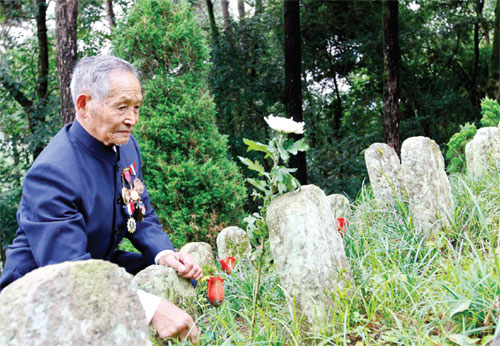The beginning of the end
Updated: 2015-08-19 07:45
By He Na(China Daily)
|
||||||||
|
Lu Caiwen, a China Expeditionary Force veteran, often visits his fallen comrades at a memorial cemetery in Tengchong, Yunnan province. [Xue Dongmei / Xinhua] |
The Chinese victory in a remote mountainous spot in southwestern China signaled the turning of the tide and the start of the endgame for the Japanese occupation of the country, as He Na reports from Tengchong, Yunnan province.
From the summit of Mount Laifeng, or "Rising Phoenix Mountain", one can see the whole of Tengchong, a county in southwestern Yunnan province, which sits along China's remote border with Myanmar.
Today, the mountain spot, a well-known tourist resort and center for weekend activities such hiking, trail-running and camping, seems idyllic, but a little more than 70 years ago it was a living hell.
At the lower levels of the mountain, the only indication of the area's turbulent history is a small commemorative stone that bears the inscription: "The main Anti-Japanese Battlefield in Dianxi" (the Chinese abbreviation for western Yunnan).
At the higher levels, however, the densely wooded hillside is pock-marked with numerous trenches, bunkers, tunnels and shell craters - old scars that tell of the fierce battles that took place during the War of Resistance Against Japanese Aggression (1937-45).
According to Li Zhicai, a researcher at the Baoshan City Museum, the defenses were dug and built by the Japanese after they occupied Tengchong in May 1942, and the interlocking subterranean network was so complex it took two years to build.
"Nowadays the summit is covered by huge, dense trees, but during the war the Japanese cut down the trees on the summit to improve visibility and make the mountain a better defensive position," Li said.
"In July 1944, the China Expeditionary Force carried out a massive counterattack in Dianxi, launching two major offensives to capture the mountain. The victory cost the lives of 10,000 CEF soldiers," he said.
The anti-fascist front
The outbreak of the war in the Pacific in December 1941 saw the Japanese launch attacks across Southeast Asia. They quickly occupied several countries, including the Philippines, Thailand and Malaysia, and also threatened the safety of Myanmar (then known as Burma) and Southwest China.
"On Jan 1, 1945, China, the United States and 24 other countries reached an agreement to establish an international anti-fascist front. In March, the 100,000-strong CEF was formed to fight alongside the British army in Myanmar and to defend China's southwestern regions," said Wu Baozhang, professor of history at Yunnan Normal University.
"However, misunderstandings and mutual suspicions hindered the operations, and the expedition failed. The CEF was forced to with draw to India, which meant Myanmar and large parts of western Yunnan fell into Japanese hands," he added.
The situation entered a stalemate as Chinese and Japanese forces faced each other across the Nujiang River until the middle of 1944.
"May 1944 to January 1945 was the time of the great counterattack. About 200,000 soldiers, mainly from the (Kuomintang) 11th and 20th group armies, re-formed the CEF to launch a counterattack. After more than eight months of fierce fighting, the CEF successfully performed a pincer movement with US troops and retook Mongyu, a town in Myanmar, on Jan 27. That marked the final victory in the war in Dianxi," Wu said.
The Battle of Laifeng Mountain is one of the best-known encounters from the period.
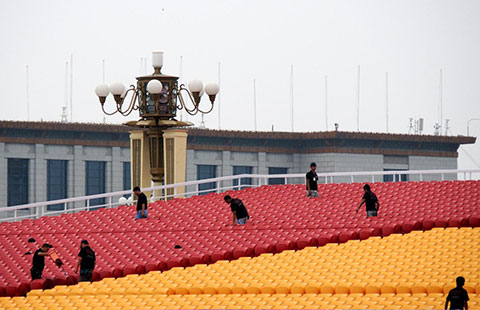
 The changing looks of Beijing before V Day parade
The changing looks of Beijing before V Day parade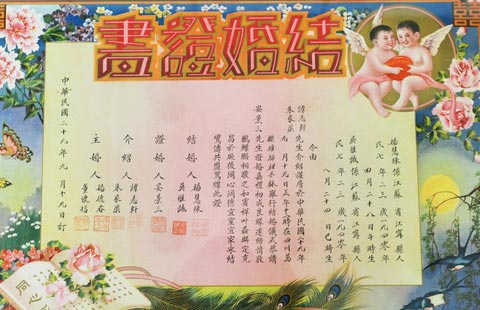
 Nanjing displays ancient marriage, divorce certificates
Nanjing displays ancient marriage, divorce certificates
 Top 10 Android app stores in China
Top 10 Android app stores in China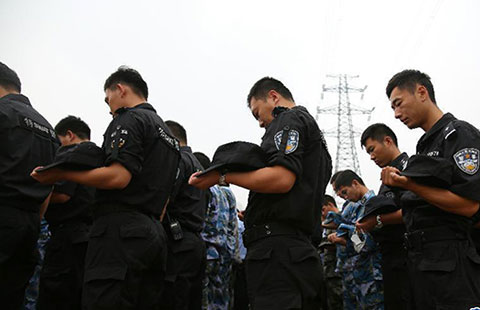
 Ceremony held to mourn victims of Tianjin blasts
Ceremony held to mourn victims of Tianjin blasts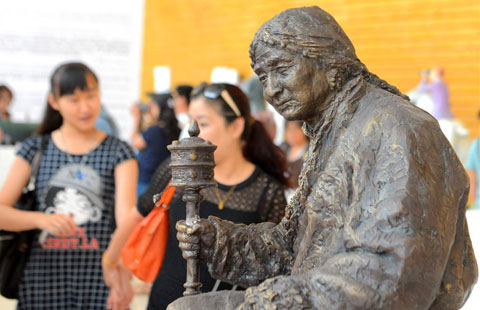
 Silk Road city displays sculptures at exhibition
Silk Road city displays sculptures at exhibition
 Top 10 companies with the most employees
Top 10 companies with the most employees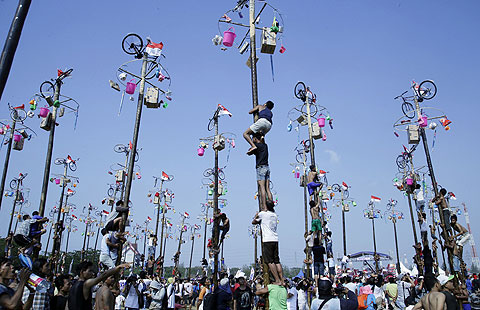
 Men in Indonesia climb greased poles to win prizes
Men in Indonesia climb greased poles to win prizes
 In pictures: Life near Tianjin blasts site
In pictures: Life near Tianjin blasts site
Most Viewed
Editor's Picks

|

|

|

|

|

|
Today's Top News
Fitch warns insured losses from Tianjin explosions could reach $1.5b
Hillary Clinton breaks with Obama on Arctic oil drilling
Man in yellow shirt is Bangkok bomber: Police
Beijing dismisses reports of Abe's China visit in September
Anti-corruption campaign 'good for China, US'
Police: Man in yellow shirt is Bangkok bomber
Rain in Tianjin poses no health risk, says official
Two HK women among four Chinese killed in Bangkok blast
US Weekly

|

|
